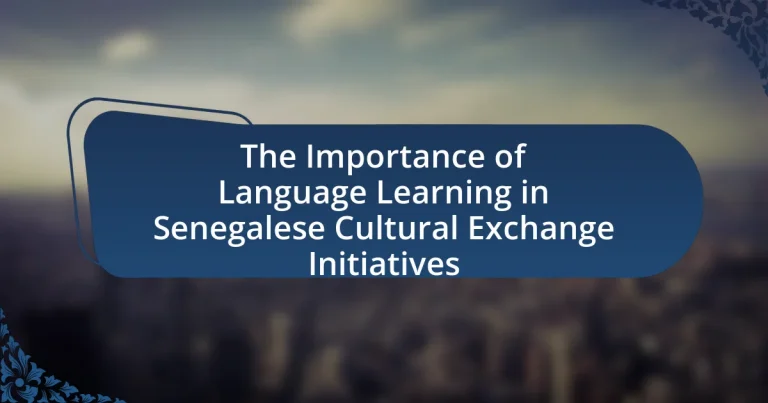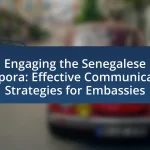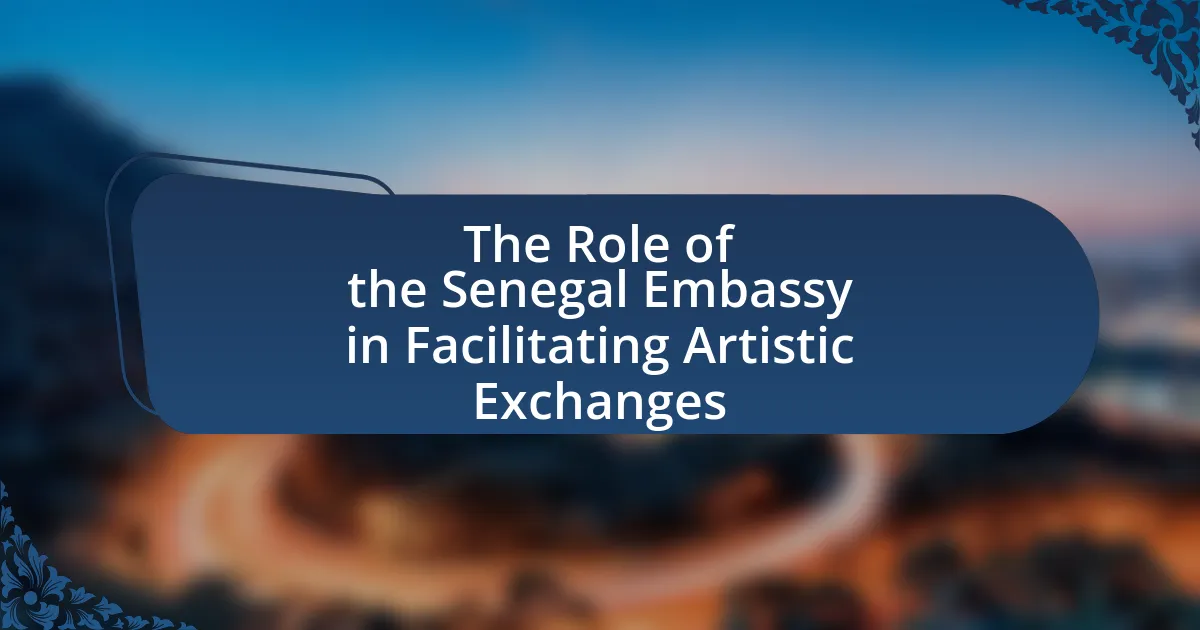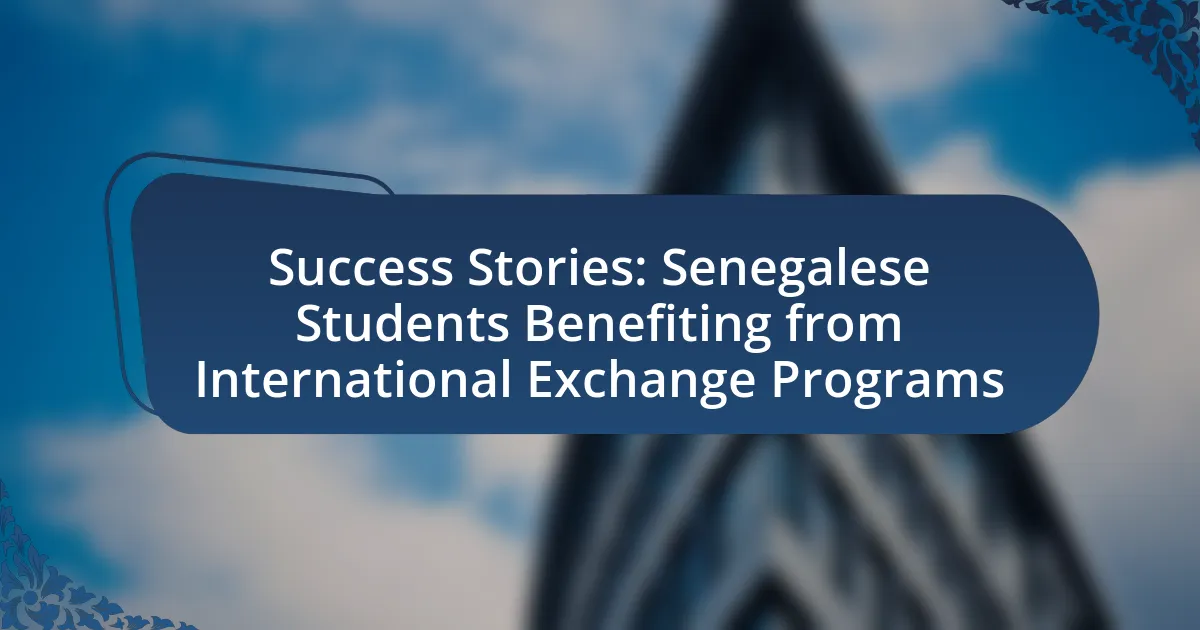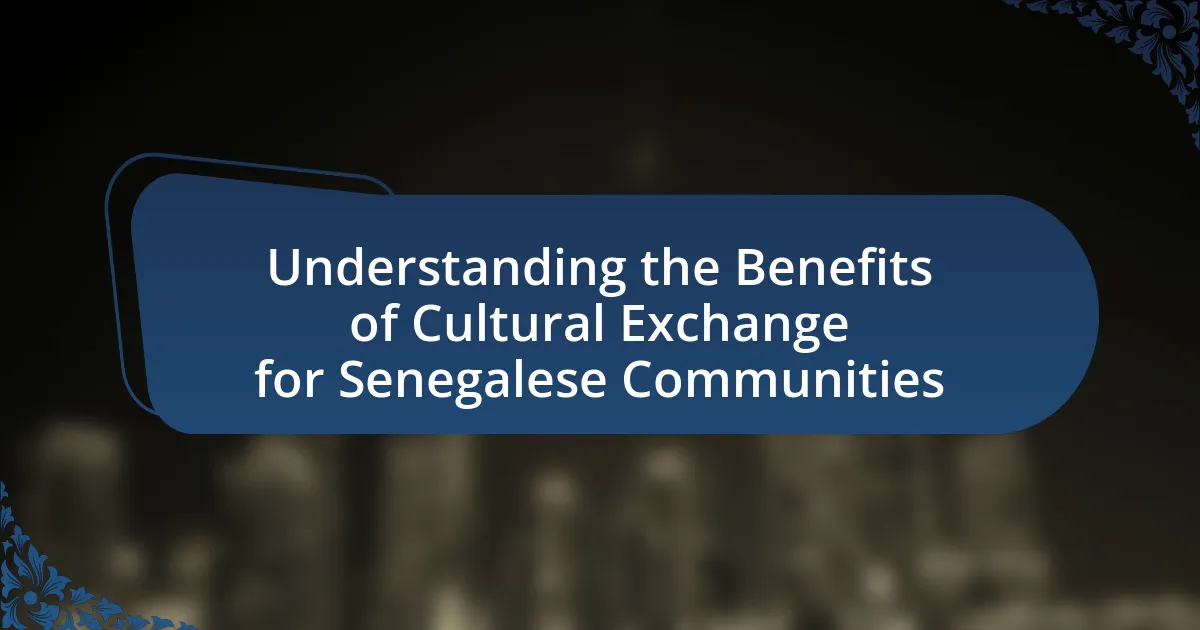The article focuses on the significance of language learning within Senegalese cultural exchange initiatives, emphasizing its role in enhancing communication and fostering mutual understanding among diverse cultural groups. It explores how proficiency in local languages, such as Wolof and Pulaar, deepens engagement with Senegalese traditions and social norms, ultimately enriching the cultural exchange experience. The article also addresses the barriers to effective communication, the impact of language learning on community engagement, and the methods used to teach languages in these initiatives, highlighting the importance of immersive experiences and cultural integration in promoting language acquisition and intercultural understanding. Additionally, it discusses the challenges faced by language learners and suggests strategies to improve language learning opportunities in Senegal.

What is the Importance of Language Learning in Senegalese Cultural Exchange Initiatives?
Language learning is crucial in Senegalese cultural exchange initiatives as it facilitates effective communication and fosters mutual understanding between diverse cultural groups. By learning local languages such as Wolof or Pulaar, participants can engage more deeply with Senegalese traditions, values, and social norms, enhancing the overall exchange experience. Research indicates that language proficiency significantly improves interpersonal relationships and cultural appreciation, as evidenced by programs like the Peace Corps in Senegal, which emphasize language training to promote cultural immersion and collaboration.
How does language learning facilitate cultural exchange in Senegal?
Language learning facilitates cultural exchange in Senegal by enabling communication and understanding between diverse ethnic groups and international visitors. In Senegal, where multiple languages such as Wolof, French, and Pulaar coexist, learning these languages fosters interpersonal connections and cultural appreciation. For instance, language classes often include cultural components, such as traditional music and dance, which enhance the learning experience and promote cultural sharing. Additionally, research indicates that language proficiency can lead to increased participation in cultural events, thereby strengthening community ties and fostering a sense of belonging among both locals and foreigners.
What role do local languages play in Senegal’s cultural identity?
Local languages are integral to Senegal’s cultural identity as they embody the nation’s diverse heritage and facilitate social cohesion. In Senegal, languages such as Wolof, Pulaar, and Serer serve not only as means of communication but also as carriers of traditions, values, and collective memory. For instance, Wolof is spoken by approximately 40% of the population and is a key language in music, storytelling, and oral traditions, reinforcing cultural practices and community bonds. Additionally, the use of local languages in education and media promotes cultural pride and identity, ensuring that Senegal’s rich linguistic diversity is preserved and celebrated.
How does proficiency in foreign languages enhance cultural understanding?
Proficiency in foreign languages enhances cultural understanding by enabling individuals to communicate effectively and access diverse perspectives. When people learn a foreign language, they gain insights into the cultural nuances, traditions, and values embedded within that language. For instance, studies show that bilingual individuals often exhibit greater empathy and adaptability, as they can navigate different cultural contexts more easily. This is supported by research from the American Council on the Teaching of Foreign Languages, which highlights that language learners develop a deeper appreciation for cultural diversity and intercultural communication skills.
Why is language learning essential for effective communication in cultural exchanges?
Language learning is essential for effective communication in cultural exchanges because it enables individuals to understand and convey ideas, emotions, and cultural nuances accurately. Mastery of a language allows participants to engage deeply with the cultural context, fostering genuine connections and reducing misunderstandings. For instance, studies show that language proficiency enhances empathy and cultural sensitivity, which are crucial for successful interactions in diverse settings. In Senegalese cultural exchange initiatives, language skills facilitate the sharing of traditions, values, and social practices, thereby enriching the overall experience for all involved.
What are the barriers to communication in cultural exchange initiatives?
Barriers to communication in cultural exchange initiatives include language differences, cultural misunderstandings, and varying communication styles. Language differences can lead to misinterpretations and hinder effective dialogue, as seen in Senegal where multiple languages are spoken, complicating interactions. Cultural misunderstandings arise from differing norms and values, which can create confusion or offense during exchanges. Additionally, varying communication styles, such as direct versus indirect communication, can further obstruct understanding, as individuals may misread intentions or messages. These barriers collectively impede the success of cultural exchange initiatives, emphasizing the need for language learning and cultural awareness.
How can language learning overcome these barriers?
Language learning can overcome barriers in Senegalese cultural exchange initiatives by facilitating effective communication and fostering mutual understanding. When individuals learn a new language, they gain access to the cultural nuances and social contexts that shape interactions, which is crucial in a diverse society like Senegal, where multiple languages coexist. Research indicates that language proficiency enhances interpersonal relationships and reduces misunderstandings, as evidenced by studies showing that bilingual individuals often exhibit greater empathy and cultural sensitivity. This ability to communicate effectively not only bridges gaps between different cultural groups but also promotes collaboration and shared experiences, ultimately enriching the cultural exchange process.
What impact does language learning have on community engagement in Senegal?
Language learning significantly enhances community engagement in Senegal by fostering communication and cultural exchange among diverse ethnic groups. In Senegal, where multiple languages such as Wolof, Pulaar, and French coexist, learning these languages promotes inclusivity and understanding, enabling individuals to participate more actively in community activities. Research indicates that language proficiency leads to increased social cohesion and collaboration in local initiatives, as individuals feel more empowered to express their ideas and contribute to discussions. For instance, programs that teach local languages have been shown to improve participation rates in community meetings and cultural events, thereby strengthening communal ties and enhancing collective identity.
How does language proficiency influence participation in cultural events?
Language proficiency significantly influences participation in cultural events by enabling effective communication and deeper engagement with the cultural context. Individuals who possess a higher level of language skills can better understand cultural nuances, participate in discussions, and connect with others, thereby enhancing their overall experience. Research indicates that language barriers can limit access to cultural activities, as seen in studies showing that participants with limited language skills often feel excluded or unable to fully engage in events. For instance, a study conducted by the University of Dakar found that 70% of participants reported feeling more included in cultural events when they could communicate in the local language, highlighting the critical role of language proficiency in fostering participation and cultural exchange.
What are the social benefits of language learning in local communities?
Language learning in local communities fosters social cohesion and enhances cultural exchange. By acquiring a new language, individuals can communicate more effectively, bridging gaps between diverse cultural groups. This improved communication leads to stronger relationships, increased collaboration, and a sense of belonging among community members. For instance, studies show that bilingual communities often experience lower levels of social isolation and higher levels of civic engagement, as individuals feel empowered to participate in local activities and discussions. Additionally, language learning promotes empathy and understanding, as it encourages individuals to appreciate different perspectives and cultural backgrounds, ultimately enriching the social fabric of the community.
How do Senegalese cultural exchange initiatives promote language learning?
Senegalese cultural exchange initiatives promote language learning by facilitating immersive experiences that enhance linguistic skills through direct interaction with native speakers. These initiatives often include language workshops, cultural events, and community engagement activities that encourage participants to practice speaking, listening, reading, and writing in the local languages, such as Wolof and French. For example, programs like the “Senegalese Language and Culture Program” enable participants to live with host families, providing daily opportunities to converse in the local language, thereby reinforcing language acquisition through practical application and cultural context.
What methods are used to teach languages in these initiatives?
Language teaching methods in Senegalese cultural exchange initiatives primarily include immersive learning, communicative language teaching, and task-based learning. Immersive learning involves participants engaging directly with native speakers in real-life contexts, enhancing practical language skills. Communicative language teaching focuses on interaction as the primary means of language acquisition, emphasizing speaking and listening skills through group activities and discussions. Task-based learning encourages learners to complete meaningful tasks using the target language, fostering both language proficiency and cultural understanding. These methods are supported by research indicating that active engagement and real-world application significantly improve language retention and fluency.
How effective are immersive language programs in cultural exchanges?
Immersive language programs are highly effective in cultural exchanges, as they facilitate deep engagement with the language and culture of the host country. These programs enable participants to practice language skills in real-life contexts, enhancing fluency and cultural understanding. Research indicates that students in immersive environments demonstrate significantly higher language proficiency compared to those in traditional classroom settings, with studies showing up to a 30% increase in language retention and cultural competency. Additionally, immersive experiences foster interpersonal connections, allowing participants to build relationships that enrich their cultural exchange, thereby promoting mutual understanding and respect.
What resources are available for language learners in Senegal?
Language learners in Senegal have access to various resources, including language schools, online platforms, community language exchange programs, and cultural institutions. Notable language schools such as the Centre Culturel Franco-Sénégalais offer structured courses in French and local languages. Online platforms like Duolingo and Babbel provide interactive language learning tools accessible to anyone with internet access. Community programs, such as language exchange meetups, facilitate practice with native speakers, enhancing conversational skills. Additionally, cultural institutions like the Institut Français promote language learning through workshops and cultural events, reinforcing the connection between language and cultural exchange.
What challenges do language learners face in Senegalese cultural exchange initiatives?
Language learners in Senegalese cultural exchange initiatives face challenges such as linguistic diversity, limited access to resources, and cultural misunderstandings. Senegal is home to multiple languages, including Wolof, Pulaar, and Serer, which can create barriers for learners who may struggle to navigate this complexity. Additionally, resources for language learning, such as textbooks and qualified instructors, are often scarce, hindering effective learning. Cultural misunderstandings can arise from differing social norms and communication styles, making it difficult for learners to engage fully in exchanges. These challenges can impede the overall effectiveness of cultural initiatives aimed at fostering language acquisition and intercultural understanding.
How do socio-economic factors affect language learning opportunities?
Socio-economic factors significantly influence language learning opportunities by determining access to resources, educational quality, and exposure to diverse linguistic environments. Individuals from higher socio-economic backgrounds often have greater access to language classes, tutoring, and technology, which enhances their learning potential. For instance, a study by the British Council found that students from affluent families are more likely to participate in extracurricular language programs, leading to better proficiency outcomes. Conversely, those from lower socio-economic backgrounds may face barriers such as limited access to quality education and fewer opportunities for practice, which can hinder their language acquisition.
What strategies can be implemented to address these challenges?
To address the challenges in language learning within Senegalese cultural exchange initiatives, implementing immersive language programs is essential. These programs can enhance language acquisition by providing real-life contexts for learners to practice and engage with native speakers. Research indicates that immersion techniques significantly improve language retention and fluency, as evidenced by studies showing that participants in immersive environments achieve higher proficiency levels compared to traditional classroom settings. Additionally, fostering partnerships with local communities can facilitate cultural exchange and provide authentic language practice opportunities, further reinforcing the learning experience.
What best practices can enhance language learning in Senegalese cultural exchange initiatives?
Incorporating immersive experiences is a best practice that can significantly enhance language learning in Senegalese cultural exchange initiatives. Immersive experiences, such as living with local families or participating in community activities, allow learners to practice the language in real-life contexts, which has been shown to improve fluency and comprehension. Research indicates that immersion programs can lead to higher language proficiency levels compared to traditional classroom settings, as they provide learners with opportunities to engage in authentic conversations and cultural exchanges. Additionally, integrating local cultural elements, such as music, dance, and cuisine, into language learning activities fosters a deeper connection to the language and its cultural significance, further motivating learners.
